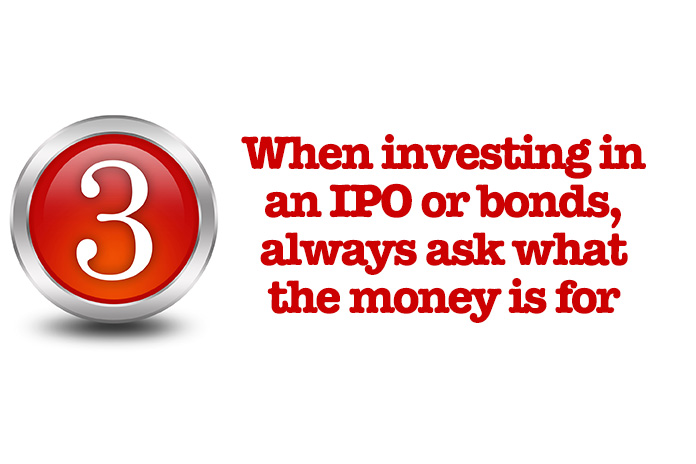
WHETHER you’re starting your investment journey, or already well under way with yours, it doesn’t hurt to remind yourself of the basics.
Anyone looking to begin their investing journey can quite readily get dozens of tips and plenty of advice from hundreds of websites and blogs or, for that matter, from their investment advisors and relationship managers.
Most of the advice is undoubtedly useful — for example, pick investments that fit your risk profile and investment horizon, make sure you diversify to reduce risk and understand all the features of a product before buying.
However, good though this advice or these tips may be, it’s pretty much standard stuff. There is however, non-standard advice which investors should always bear in mind, certain uncomfortable truths associated with investing that are not usually widely publicised but are just as important for investors to know.
They won’t necessarily help you make lots of money, but being aware of them will help investors avoid making mistakes and possibly minimise their losses. I covered the local stock market for the Business Times for 25 years and one of the most frequently-asked questions asked of me was “I’d like to make some money, so what’s good to buy?’’
I covered the local stock market for the Business Times for 25 years and one of the most frequently-asked questions asked of me was “I’d like to make some money, so what’s good to buy?’’
Initially I tried to answer as best I could, naming stocks which I thought might perform in the near future, perhaps because of expected superior earnings, or maybe because they were trading far below their asset or book values.
After countless times of trying earnestly to give proper advice, it struck me that no one every makes money after buying something but only after they’ve sold it.
Sure, if you buy something today and it rises tomorrow or next week or next month, there’s a psychological, feelgood boost that you’re doing well. However, if you don’t sell and realise the profit, then you’ve made nothing…which leads to the next tip. The vast majority of investment advisors, stockbrokers, relationship managers, and financial planners will always have ideas on what and when to buy, but very few will ever advise you on when to sell.
The vast majority of investment advisors, stockbrokers, relationship managers, and financial planners will always have ideas on what and when to buy, but very few will ever advise you on when to sell.
In stockbroking research for instance, there is usually an institutionalised reluctance to call a “sell’’ on a stock, especially if it’s a prominent blue chip like a bank, conglomerate or leading property company.
One reason for this is that analysts do not want to upset the companies they cover and in the process lose access to senior management on whom they rely for corporate insights by issuing a “sell’’ recommendation on the shares of those companies.
In this connection, there have been companies who would not invite to their briefings analysts who issued unflattering reports on the shares of those companies. This placed subtle but nevertheless significant pressure on the research community to always put a positive bias to their recommendations.
This could be why stockbrokers try very hard to avoid the word “sell’’ and instead have formulated various imaginative “non-buy’’ calls such as “accumulate on weakness’’, “hold’’ or “underperform’’.
The important lesson here for individuals is that in today’s market that is governed by the principle of caveat emptor or “buyer beware’’, the responsibility for deciding when to buy and sell is largely yours, and yours alone.
Of course, if the financial institution gave you advice and you acted on that advice, then there may be some recourse, just as whenever there has been mis-selling.
However, for the most part, as long as all material information has been disclosed, it is up to the individual investor to decide for himself or herself when to buy and, perhaps more importantly, when to sell. If someone approaches you for a loan, one of the first and most logical questions, apart from what the risks are, would be: “What is the money for?“
If someone approaches you for a loan, one of the first and most logical questions, apart from what the risks are, would be: “What is the money for?“
This seems simple enough, but it is not a question that the public is encouraged to think about when it comes to subscribing to a new issue, whether it is an initial public offering (IPO) or bonds. Instead, the way IPOs or a bond issue is marketed and publicised directs investors to ask: “Can buy or not?’’
When a company goes public via an IPO it is basically asking for money to expand its business or for some specific corporate purpose. The same goes for a retail bond issue; bonds being borrowings issued by companies or governments.
The details of an IPO are contained in a prospectus which is usually several hundred pages thick. Nobody can realistically be expected to read these documents in the days between lodgement and commencement of trading, so the important features are then summarised into a shorter document called a Products Highlight Sheet (PHS) which is usually about a dozen pages thick.
Similarly, all the salient features of a bond issue will also be condensed into a PHS. In all cases, the PHS will be posted online, and they should be read before investing — though chances are they are not, at least not widely.
Inside these documents will appear the Use of Proceeds, which should be arguably one of most important considerations when deciding whether to invest, but unfortunately hardly ever features in most people’s decision-making.
In a typical IPO prospectus, Use of Proceeds being undeniably important, should appear on the cover. Instead, it is always buried inside. For bonds, the Use of Proceeds usually appears towards the end of the PHS. In both cases, the impression thus given is that how the money is to be used is only an afterthought.
The reality is that examining the use of IPO proceeds has shown in several cases that only 20 to 50 cents of every dollar invested goes towards core businesses. In many instances, a sizeable portion is used to pay off debts, bank loans, “working capital’’ and major shareholders who are known as vendors.
These are of course valid uses of IPO funds and does not mean companies that only channel a small proportion of the money raised towards their core businesses should not be allowed to list.
However, if so, then why not disclose Use of Proceeds more prominently?
There is no starker example of the importance of asking about the use of proceeds than that of a perpetuals issue by failed water treatment firm Hyflux Ltd.
In May 2016, Hyflux offered the retail public a total of $500 million of an instrument known as a perpetual that paid a coupon rate of 6% per annum. The initial issue size was $300 million but this was raised by $200 million because of large demand, most likely because the coupon was very attractive given how low bank rates were at the time.
The problem is that very few of the 34,000 investors — many of whom were retirees — who poured their money into this issue appeared to have taken the trouble to check what the money was for, but those who did would have found that $475 million went towards redeeming perpetuals issued in 2014 to institutions and accredited investors.
In other words, how many people can reasonably be expected to have invested in these perpetuals if they had known their money was going to pay off rich investors? Would the size of the issue have been raised due to demand if this fact had been widely and prominently publicised?
All the material information was actually fully disclosed, though some of it was in footnotes in the PHS. No matter, recall that applying the principle of caveat emptor, as long as the correct information did in fact appear and investors did not ask what the money was for and do their checks, then it’s just too bad.
Given that Hyflux is now under judicial management, is being wound up and some of its directors are under criminal investigation, it remains to be seen just how much these investors will recoup. It isn’t likely to be anything meaningful.
The views expressed are those of the author.



















